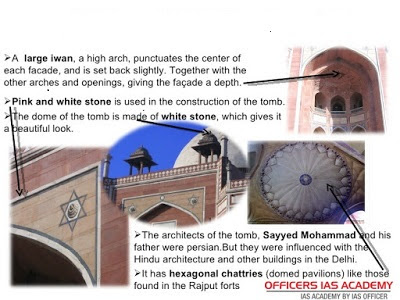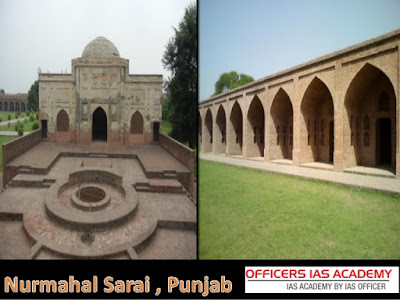Tombs
·
Monumental structures over graves of
rulers and royalty was a popular feature of medieval
India.
·
Some well known examples of such
tombs are those of Ghyasuddin Tughlaq, Humayun, Adur
Rahim Khan-i-Khanan, Akbar, and Itmaduddaula.
·
The idea behind the tomb was eternal
paradise as a reward for the true believer on the Day of Judgment.
This leads to the paradisiacal imagery for tombs.
·
Beginning with the introduction of Quranic verses on the walls, the tomb was subsequently placed with
paradisiacal elements such as garden or near a water body or both, as in the
case of Taj Mahal.
·
They were not only intended to
signify peace and happiness in the next world, but also to showcase the majesty, grandeur and might of the
person buried there.
1.Taj Mahal
·
Taj Mahal was built in Agra by Shah Jahan
as a mausoleum (a kind of large tomb) for his deceased wife Mumtaz Mahal.
·
It was commissioned in the year of 1632 and is a
UNESCO World Heritage Site.
·
Taj Mahal was the apogee of the evolutionary architectural process in medieval India.
·
The Taj complex is entered through a monumental red sandstone gateway, the opening arch of which beautifully frames the
mausoleum.
·
The tomb is laid out in a Chahar Bagh (garden),
crisscrossed with paths and water courses, interspersed with pools and
fountains.
·
The structure is placed on the
northern extremity of the bagh instead of the middle to take the advantage of
the river bank (Yamuna).
·
The straight path through the bagh
reaches the plinth of the tomb.
·
At the corners of the terrace stand four
tall minarets, one hundred and thirty two feet
high.
·
The main body of the building is
topped with a drum and a dome and four cupolas
forming a beautiful skyline.
·
Towards the west of the white marble faced tomb lies a red sandstone mosque and a similar construction in the east to maintain
balance.
·
The marbles for the building was quarried from the Makrana Mines, Rajasthan.
·
The inner arrangement of the
mausoleum consists of a crypt below and a vaulted, octagonal tomb chamber, with
a room at each angle, all connected by corridors.
·
Light to every part of the building
is obtained by means of carved and perforated Jalis, set in the arched recesses of the
interior.
·
Four types of embellishments have
been used with great effect for the interior and exterior surfaces of the Taj
Mahal.
·
These are stone carvings in high and low relief on the walls, the delicate carving
of marble into jails and graceful volutes (spiral ornament on the pillars), and the creation of arabesque
with pietra
dura on
walls and tombstones and geometric designs with tessellation.
·
The art of calligraphy is used with the inlay of jasper in white marble to unite Quranic verses.
·
Calligraphy provides a decorative element on the walls and a continuous
connection with the almighty.
2. Gol Gumbad, Karnataka :
·
It is situated in the Bijapur district of Karnataka.
·
It is the mausoleum of Muhammed Adil Shah, the 7th sultan of the Adil Shahi Dynasty of
Bijapur (1498-1686).
·
Built by the ruler himself, it is a striking edifice in spite of being unfinished.
·
The tomb is a complex building such
as a gateway, a Naqqar Khana, a mosque and a sarai located within a large walled garden.
·
Gumbad is a square building topped with a circular drum
over which rests a majestic dome, giving the building its nomenclature.
·
It is built of dark grey basalt and decorated plaster work.
·
The dome of Gol Gumbad is the largest
in the world.
·
The building has an amazing
acoustical system. Along with the drum of the dome, there is a whispering
gallery where sounds get magnified and echoed many
times over.
·
While its structural peculiarities of
dome, arches, geometric proportions and load bearing techniques suggest Timurid and Persian styles, it is made of local material and is decorated with surface
embellishments popular in Deccan.
Sarais :
·
Sarais were largely built on a simple square or a rectangular plan and were meant to provide temporary accommodation for
Indian and foreign travelers, pilgrims, merchants,
traders, etc.
·
They were public domains which thronged with people of varied cultural backgrounds.
·
This lead to cross cultural interaction, influence and syncretic
tendencies in the cultural mores of
the times and at the level of people.
Structures
for common people :
·
One of the architectural features of
medieval India was also a coming together of styles, techniques, and
decorations in public and private spaces for non-royal sections of the society.
·
These include buildings for domestic
usage, temples, mosques, Khanqahs and dargahs, commemorative gateways,
pavilions in the buildings and gardens, bazaars, etc.
Jama Masjid:
·
Large mosques spanning huge spaces
also dotted the landscapes of the Indian sub-continent in medieval times.
·
Congregational
prayers were held here every Friday afternoon, which required the presence of minimum of forty Muslim male adults.
·
At the time of prayers, a khutba was read
out in the name of the ruler and his
laws for the realm were also read out.
·
In medieval times, a city had one Jama Masjid which, along with its immediate surroundings, became the focus
of the lives of the people, both Muslim and Non-Muslim.
·
This happened because a lot of
commercial and cultural exchanges were concentrated here besides religious and
indirect political activity.
·
Generally, such a mosque was large
with an open courtyard, surrounded on three sides by cloisters and the Qibla
Liwan in the west.
·
It was here that the mihrab and mimbar for the Imam were located.
·
People
faced the mihrab while
offering prayers as it indicated the direction of the Kaaba
in Mecca.
Additional Note: Architecture
in Mandu, Madhya Pradesh = Provincial Style ;
·
The city of Mandu is located
in Madhya Pradesh, at an elevation of over 2000 feet and overlooks the Malwa Plateau to the north and the Narmada
valley to the south.
·
Mandu’s natural defence encouraged
consistent habitation by Parmana Rajputs, Afghans, and Mughals.
·
As the capital city of the Ghauri Dynasty
(1401-1561) founded by Hoshang Shah, it acquired a lot of fame.
·
Mandu was associated with the romance
of Sultan Baz Bahadur and Rani Rupamati.
·
The Mughals resorted to it for
pleasure during the monsoon season.
Art and
Architectures of Mandu :
·
Mandu is a typical representation of
the medieval provincial style of art and architecture.
·
It was a complex mix of official and residential-cum-pleasure
palace, pavilions, light and airy, so that
these buildings did not retain heat.
·
Local stone and marble were used to
great advantage.
·
The royal enclave located in the city
comprised the most complete and romantic set of buildings, a cluster of palaces
and attendant structures, official and residential, built around two artificial
lakes.
Eg: 1. The Hindola Mahal,
Mandu :
·
It looks like a railway viaduct bridge with its disproportionately large buttresses supporting
the walls.
·
This was the audience hall of the Sultan and the place where he showed himself to his subjects.
·
Batter was used very effectively to give an impression of swinging
(Hindola) walls.
Eg: 2. Jahaaz Mahal, Mandu :
·
It is an elegant two storey ‘Ship Palace’ between two reservoirs, with open pavilion, balconies
overhanging the water and a terrace.
·
It was built by Sultan Ghiyasuddin Khilji and was possibly used as his harem and the ultimate
pleasure and recreation resort.
·
It had a complex arrangement of watercourses
and a terrace swimming pool.
Eg: 3.Rani Rupamati’s Pavilion, Mandu :
·
Rani Rupamati’s double pavilion perched on the southern embattlements
afforded a beautiful view of the Narmada valley.
·
Baz Bahadur’s Palace had a wide courtyard ringed with halls and terrace.
Eg: 4.Hoshang Shah’s Tomb, Mandu :
·
It is a majestic structure with a
beautiful dome, marble jail work, porticos, courts, and towers.
·
It is regarded as an example of the robustness of Afghan structures, nut its lattice works, carved brackets and torans lend
it a softer hue.
Eg: 5.Jama Masjid, Mandu :
·
It was built on a large scale to
accommodate many worshippers for Friday prayers.
·
The building is faced with red sandstone.
·
The Mimbar (where Imam stands to deliver sermons) in the Quibla liwan (a long narrowed hall) is supported
on carved brackets and the Mihrab has a lotus bud fringe.


































Thank you for sharing such important information. It will be very useful for us in future. Good keep it up and keep writing. Read more about
ReplyDeleteUPSC Book Shop
UPSC Books
URGENT LOAN IS AVAILABLE NOW
ReplyDeleteTODAY I GOT MY DESIRED LOAN AMOUNT $760K FROM A RELIABLE,TRUSTED AND REGISTERED PRIVATE LOAN COMPANY LAST WEEK,BUSINESS/HOME/COMPANY/PROJECT/PERSONAL LOAN? ARE NOW AFFORDABLE HERE FOR YOU TODAY CONTACT Email profdorothyinvestments@gmail.com
Hello, I'm here to testify of how i got my real estate business loan from PROF. MRS.DOROTHY JEAN INVESTMENTS (profdorothyinvestments@gmail.com) I don't know if you are in need of an urgent loan to pay bills, start business or build a house, they offer all kinds of loan Ranging from $5,000.00USD to $2,000,000.00USD with a low interest rate of 2% and loan duration of 1 to 33 years to pay back the loan secure and unsecured. Are you losing sleep at nights worrying how to get a Legit Loan Lender?
MRS.DOROTHY JEAN holds all of the information about how to obtain money quickly and painlessly without cost/stress via Contacts Email profdorothyinvestments@gmail.com
Инстраграмм являться самой популярной площадкой для продвижения собственного бизнеса. Но, как показывает практика, люди гораздо чаще подписываются на профили в каких уже достаточное количество подписчиков. Если заниматься продвижение своими силами, потратить на это можно очень немало времени, потому гораздо лучше обратиться к специалистам из Krutiminst.ru подробнее https://dominickuofw98765.blogcudinti.com/15879978/ways-to-get-instagram-followers-fast
ReplyDelete